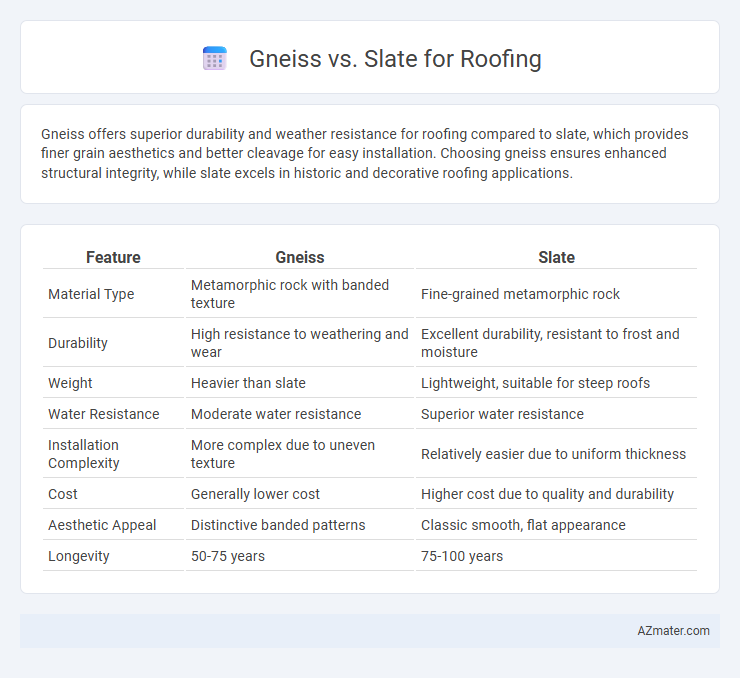Gneiss offers superior durability and weather resistance for roofing compared to slate, which provides finer grain aesthetics and better cleavage for easy installation. Choosing gneiss ensures enhanced structural integrity, while slate excels in historic and decorative roofing applications.
Table of Comparison
| Feature | Gneiss | Slate |
|---|---|---|
| Material Type | Metamorphic rock with banded texture | Fine-grained metamorphic rock |
| Durability | High resistance to weathering and wear | Excellent durability, resistant to frost and moisture |
| Weight | Heavier than slate | Lightweight, suitable for steep roofs |
| Water Resistance | Moderate water resistance | Superior water resistance |
| Installation Complexity | More complex due to uneven texture | Relatively easier due to uniform thickness |
| Cost | Generally lower cost | Higher cost due to quality and durability |
| Aesthetic Appeal | Distinctive banded patterns | Classic smooth, flat appearance |
| Longevity | 50-75 years | 75-100 years |
Understanding Gneiss and Slate: An Overview
Gneiss and slate are both metamorphic rocks commonly used in roofing due to their durability and aesthetic appeal. Gneiss features a coarse-grained texture with alternating bands of light and dark minerals, providing a distinctive, natural layered appearance ideal for high-end roofing projects. Slate is fine-grained, known for its uniform texture, excellent cleavage, and water resistance, making it a traditional, long-lasting roofing material favored in historic and modern constructions.
Geological Formation and Properties
Gneiss forms through high-grade regional metamorphism, characterized by its distinct foliation and banded texture resulting from the reorganization of minerals under intense heat and pressure, making it exceptionally durable and resistant to weathering. Slate originates from low-grade metamorphism of shale, displaying a fine-grained, foliated structure with excellent cleavage planes that enable it to be split into thin, flat sheets ideal for roofing. The high compressive strength of gneiss supports structural integrity over time, while slate's low porosity and natural cleavage offer superior waterproofing and ease of installation.
Durability and Lifespan Comparison
Gneiss roofing offers superior durability due to its dense, coarse-grained structure, providing excellent resistance to weathering and mechanical wear. Slate, known for its fine-grained, foliated texture, excels in lifespan, often lasting over 100 years with minimal maintenance. Both materials outperform traditional roofing options, but slate's low porosity and natural cleavage contribute to a longer-lasting, water-resistant roof surface.
Aesthetic Differences and Visual Appeal
Gneiss roofing offers a distinctive, coarse-grained texture with swirling bands of color that create a dynamic, natural appearance, while slate provides a smooth, uniform surface characterized by deep, rich hues and a classic, elegant appeal. The visual appeal of gneiss lies in its varied mineral patterns and earthy tones, making each roof uniquely vibrant, whereas slate's consistent layering and subtle color variations convey timeless sophistication and refined simplicity. Choosing between gneiss and slate for roofing largely depends on desired architectural style, with gneiss complementing rustic or contemporary designs and slate often preferred for traditional or historic aesthetics.
Weather Resistance and Performance
Gneiss offers superior weather resistance for roofing due to its coarse-grained texture and high density, which provide excellent durability against freeze-thaw cycles and heavy rainfall. Slate, known for its fine-grained, foliated structure, excels in performance by offering natural water resistance and resistance to chemical weathering, ensuring long-lasting protection in harsh climates. Both materials deliver strong weather-resistant roofing options, but gneiss is preferred for rugged, extreme weather conditions, while slate provides a sleek appearance with proven longevity in varied environments.
Installation Challenges and Requirements
Gneiss roofing requires specialized cutting tools due to its coarse grain structure, making installation labor-intensive and demanding precise handling to avoid cracks. Slate, known for its fine-grained composition, allows for thinner, lighter tiles but necessitates careful nailing and aligned spacing to prevent breakage and ensure weather resistance. Both materials demand experienced installers familiar with natural stone roofing techniques to maintain durability and aesthetic integrity.
Cost Analysis: Gneiss vs Slate Roofing
Slate roofing typically costs between $15 to $30 per square foot due to its natural durability and aesthetic appeal, making it a premium choice for roofing materials. Gneiss roofing, although less common, generally ranges from $10 to $20 per square foot, offering a more budget-friendly alternative while still providing strong weather resistance and longevity. When comparing cost analysis, gneiss roofing presents a more economical option with similar functional benefits, whereas slate demands a higher initial investment but offers exceptional lifespan and minimal maintenance.
Maintenance Needs and Upkeep
Gneiss roofing requires minimal maintenance due to its durability and resistance to weathering, with occasional inspections to check for loose or damaged tiles. Slate roofing demands more frequent upkeep, involving regular cleaning to prevent moss and algae buildup, as well as prompt repairs to cracked or broken pieces to maintain its longevity. Both materials benefit from professional assessments every few years to ensure optimal performance and aesthetic appeal.
Environmental Impact and Sustainability
Gneiss roofing offers durability and low maintenance, reducing the need for frequent replacement and minimizing environmental waste. Slate is a natural, recyclable material with excellent longevity, supporting sustainable roofing practices by lowering the carbon footprint over its lifespan. Both stones are quarried, but careful sourcing and responsible extraction methods influence their overall environmental impact and sustainability profile.
Choosing the Right Material for Your Roof
Gneiss offers exceptional durability and a unique, natural texture ideal for roofing projects demanding long-lasting strength and aesthetic appeal. Slate is renowned for its fine-grained structure, superior water resistance, and elegant, smooth finish, making it a preferred choice for traditional and high-end roofing. Selecting between gneiss and slate depends on factors such as budget, climate resistance, visual preference, and structural load capacity to ensure optimal roof performance.

Infographic: Gneiss vs Slate for Roofing
 azmater.com
azmater.com